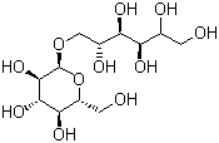Chemical Name: Isomalt
Synonyms: Palatinitol
CAS No: 64519-82-0
Molecular Formula: C24H48O22
Molecular Weight: 688.62
Appearance: white powder
Assay: 98%min
Chemical Name: Isomalt
Synonyms: Palatinitol
CAS No: 64519-82-0
Molecular Formula: C24H48O22
Molecular Weight: 688.62
Appearance: white powder
Assay: 98%min
Isomalt Quick Details
Chemical Name: Isomalt
CAS No: 64519-82-0
Molecular Formula: C24H48O22
Molecular Weight: 688.62
Molecular Structure:
Appearance: white powder
Assay: 98%min
Typical Properties
| Item | Specifications |
| GPS GPM-Content(on dry basis) | 97.0%-102.0% |
| sorbltol and D-mannitol(on dry basis) | ≤2.0% |
| Reducing sugar (as glucose) | ≤0.3% |
| Loss on drying | ≤7.0% |
| Ignition residue | ≤0.1% |
Usage
Functional edible sugar alcohol has become an important raw material widely used in many low calorie foods and medicines.
Use as a sweetener: By far the most common use of isomalt is as an additive to “sugar-free” candies, cough drops, and other commercial foods. It’s about as sweet as natural sugar, but without the blood sugar and calorie concerns. Of course, this substitute is not completely caloric, but it has only about half the calories of sugar. As a result, it can’t be used in zero-calorie products. Because it doesn’t cause tooth decay like sugar, many toothpastes use it to improve the taste.
Although it doesn’t bake or react like sugar, other non-sugar sweeteners such as sucralose are sometimes mixed with isomalt to produce a sugar-like sweetness. For example, it doesn’t dissolve quickly, doesn’t look or taste the same, and some forms designed for baking are actually bitter. The compound is often processed into granules using chemicals such as acesulfame potassium, so it gives people an unpleasant taste when ingested alone.
Packaging and Shipping
Regular package: 25kg/bag.
Delivery: 10-15 days after receipt the payment
Storage
Store at 2-8°C